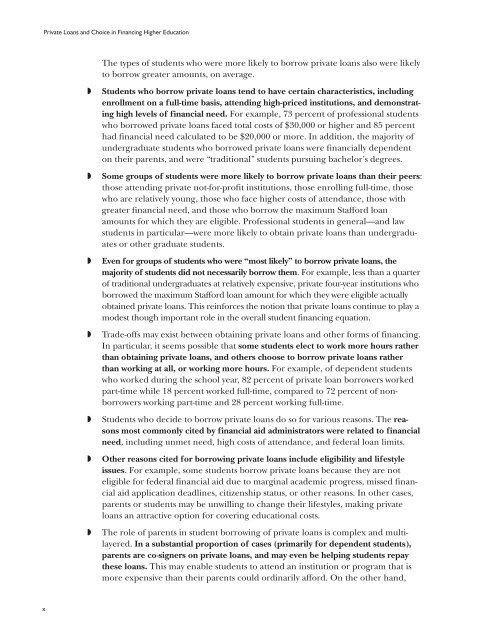Private Loans and Choice in Financing Higher Education - College ...
Private Loans and Choice in Financing Higher Education - College ...
Private Loans and Choice in Financing Higher Education - College ...
Create successful ePaper yourself
Turn your PDF publications into a flip-book with our unique Google optimized e-Paper software.
<strong>Private</strong> <strong>Loans</strong> <strong>and</strong> <strong>Choice</strong> <strong>in</strong> F<strong>in</strong>anc<strong>in</strong>g <strong>Higher</strong> <strong>Education</strong>The types of students who were more likely to borrow private loans also were likelyto borrow greater amounts, on average.◗◗◗◗◗◗◗Students who borrow private loans tend to have certa<strong>in</strong> characteristics, <strong>in</strong>clud<strong>in</strong>genrollment on a full-time basis, attend<strong>in</strong>g high-priced <strong>in</strong>stitutions, <strong>and</strong> demonstrat<strong>in</strong>ghigh levels of f<strong>in</strong>ancial need. For example, 73 percent of professional studentswho borrowed private loans faced total costs of $30,000 or higher <strong>and</strong> 85 percenthad f<strong>in</strong>ancial need calculated to be $20,000 or more. In addition, the majority ofundergraduate students who borrowed private loans were f<strong>in</strong>ancially dependenton their parents, <strong>and</strong> were “traditional” students pursu<strong>in</strong>g bachelor’s degrees.Some groups of students were more likely to borrow private loans than their peers:those attend<strong>in</strong>g private not-for-profit <strong>in</strong>stitutions, those enroll<strong>in</strong>g full-time, thosewho are relatively young, those who face higher costs of attendance, those withgreater f<strong>in</strong>ancial need, <strong>and</strong> those who borrow the maximum Stafford loanamounts for which they are eligible. Professional students <strong>in</strong> general—<strong>and</strong> lawstudents <strong>in</strong> particular—were more likely to obta<strong>in</strong> private loans than undergraduatesor other graduate students.Even for groups of students who were “most likely” to borrow private loans, themajority of students did not necessarily borrow them. For example, less than a quarterof traditional undergraduates at relatively expensive, private four-year <strong>in</strong>stitutions whoborrowed the maximum Stafford loan amount for which they were eligible actuallyobta<strong>in</strong>ed private loans. This re<strong>in</strong>forces the notion that private loans cont<strong>in</strong>ue to play amodest though important role <strong>in</strong> the overall student f<strong>in</strong>anc<strong>in</strong>g equation.Trade-offs may exist between obta<strong>in</strong><strong>in</strong>g private loans <strong>and</strong> other forms of f<strong>in</strong>anc<strong>in</strong>g.In particular, it seems possible that some students elect to work more hours ratherthan obta<strong>in</strong><strong>in</strong>g private loans, <strong>and</strong> others choose to borrow private loans ratherthan work<strong>in</strong>g at all, or work<strong>in</strong>g more hours. For example, of dependent studentswho worked dur<strong>in</strong>g the school year, 82 percent of private loan borrowers workedpart-time while 18 percent worked full-time, compared to 72 percent of nonborrowerswork<strong>in</strong>g part-time <strong>and</strong> 28 percent work<strong>in</strong>g full-time.Students who decide to borrow private loans do so for various reasons. The reasonsmost commonly cited by f<strong>in</strong>ancial aid adm<strong>in</strong>istrators were related to f<strong>in</strong>ancialneed, <strong>in</strong>clud<strong>in</strong>g unmet need, high costs of attendance, <strong>and</strong> federal loan limits.Other reasons cited for borrow<strong>in</strong>g private loans <strong>in</strong>clude eligibility <strong>and</strong> lifestyleissues. For example, some students borrow private loans because they are noteligible for federal f<strong>in</strong>ancial aid due to marg<strong>in</strong>al academic progress, missed f<strong>in</strong>ancialaid application deadl<strong>in</strong>es, citizenship status, or other reasons. In other cases,parents or students may be unwill<strong>in</strong>g to change their lifestyles, mak<strong>in</strong>g privateloans an attractive option for cover<strong>in</strong>g educational costs.The role of parents <strong>in</strong> student borrow<strong>in</strong>g of private loans is complex <strong>and</strong> multilayered.In a substantial proportion of cases (primarily for dependent students),parents are co-signers on private loans, <strong>and</strong> may even be help<strong>in</strong>g students repaythese loans. This may enable students to attend an <strong>in</strong>stitution or program that ismore expensive than their parents could ord<strong>in</strong>arily afford. On the other h<strong>and</strong>,x
















